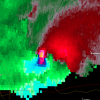-
Posts
20,321 -
Joined
-
Last visited
Content Type
Profiles
Blogs
Forums
American Weather
Media Demo
Store
Gallery
Everything posted by andyhb
-

Historic Lake Effect Event?! 11/17-11/21
andyhb replied to BuffaloWeather's topic in Upstate New York/Pennsylvania
Just chiming in to say this one looks like a doozy, certainly haven't seen this type of potential since Nov 2014. Duration might exceed that and the thermos shouldn't be terribly far off thanks to the record lake temperatures. Looks a potential once-in-a-decade type event if not larger. -

Major November Outbreak Possible
andyhb replied to Tallis Rockwell's topic in Central/Western States
Now have a pair of EF4 tornadoes confirmed from this outbreak. Powderly TX and Clarksville TX/Idabel OK. -

Central/Southern Plains Severe Weather Palooza (4/29 - 05/05)
andyhb replied to Powerball's topic in Central/Western States
So far the HRRR has the best handle on current convective evolution, with the NAM 3 km and NSSL WRF being far too bullish on early elevated convection. The environment close to the warm front later looks pretty dangerous from CDS towards OKC. Seems like a low-level flow has ramped up in forecasts as well the closer we've gotten to verification. -

Central/Southern Plains Severe Weather Palooza (4/29 - 05/05)
andyhb replied to Powerball's topic in Central/Western States
Monday is trouble for S KS and OK. There will be early convection with the lead wave that passes through, but there is a signal across the board for recovery in its wake with upper 60s dewpoints returning towards the KS/OK border as a strong/progressive shortwave emerges from the Rockies. Should we see recovery and initiation, which I think is nearly certain in S KS and slightly less likely further south, it will take place in a very moist low level environment with hodographs favorable for tornadic supercells. There is regional severe event potential depending on how many storms develop. -
TTU WRF also has a couple of intense supercells moving across northern OK later tomorrow afternoon. Seems most of the WRF based guidance is pretty bullish on tomorrow's prospects regarding CI on the dryline, although longevity of the storms still is TBD. Seems like the KS stuff may struggle if it moves into the more stable air too quickly, while any OK storms may have a longer runway of favorable conditions should CI occur that far south.
-
That wave ejecting on Friday definitely has some potential for the southern/central Plains. GFS is the most aggressive and is pretty classic looking both at the surface and 500 mb. Other models are a bit more subdued, need to watch the moisture quality.
-

2022 Short/Medium Range Severe Weather Discussion
andyhb replied to Chicago Storm's topic in Lakes/Ohio Valley
I think we’re going to need a dedicated thread for Wednesday soon enough. If that trough deamplifies any further from current progs, you’re going to see a scenario where the upper forcing is spread across a very large warm sector (from the Lower MS Valley to Upper Midwest) with favorable moisture and shear profiles for supercells and tornadoes. To me, it has the potential of a large scale outbreak, especially if the NAM/UK/Euro blend are on the right track. -
Definitely have concerns that the I-35 corridor in central/S TX including the Austin/Round Rock and San Antonio metros will be targeted tomorrow around rush hour, which is already hectic at the best of times. Many of the afternoon CAM runs indicate the potential for supercells initiating off the Edwards Plateau with very large hail and tornadoes given the forecast soundings around that time. This isn't exactly an area known for potent synoptic severe weather events, either.
- 355 replies
-
- 2
-

-
Rumours of the La Nina's demise were greatly exaggerated.
-

2022 Short/Medium Range Severe Weather Discussion
andyhb replied to Chicago Storm's topic in Lakes/Ohio Valley
2 EF3s, Winterset actually may have a shot at EF4 based on some of the damage I've seen. That was a nasty tornado. -
Michigan: where exciting weather goes to die.
- 856 replies
-
- 10
-

-

-

-

-
Here they are.
-
Someone needs to dig up the baro post in @Thundersnow12's sig for nostalgic purposes, since I'm pretty sure it was about now 11 years ago that things started to go to hell in a hand basket around these parts.
-
I have a bad feeling about I-44 particularly in OK with this one. Setup screams either a big sleet event with snow/ZR mixed in, or a nasty ice storm.
-
Ready 2 b buried?
-
Thought the same thing looking at that. If we get that shortwave to amplify just a bit more and eject more intact, not only does the potential for a blizzard go up, but I could see jackpots approaching 2 feet from that wave alone given how moisture logged this thing is. Effectively, this thing is basically two storms in one.
-
N IN and NW OH absolutely destroyed.
-
18z GFS is going to be an absolute crush job. Wider swath of large accumulations with the lead wave and the second one is coming in deeper.
-
Northern stream looks like it's going to be too dominant on the Euro.
-
St. Louis and Indy get absolutely shellacked by the CMC, I-70 special.
-
Did places in N RI and SE MA legit get 4 feet in 1978 or is that just urban legend? Most maps I see from that are around 3 feet or so in the jackpot zones.
-
QPF output on some of these models is nutty. Not very often where you talk about such a moisture laden system that lasts awhile, but this could be it.
-
Too sheared out.
-
This is looking like a top 5er potentially for the general Boston area.


